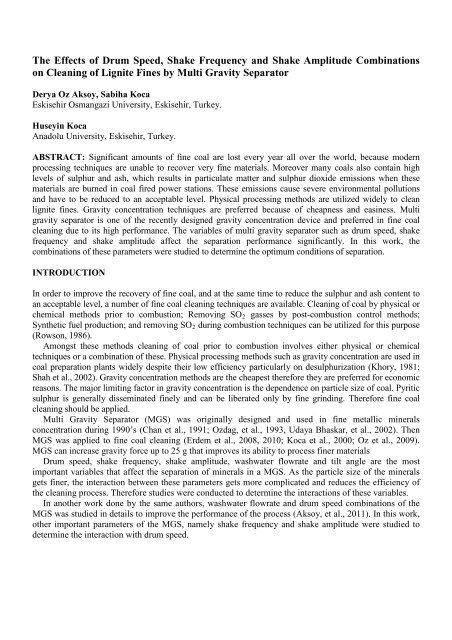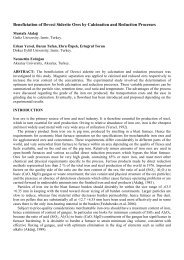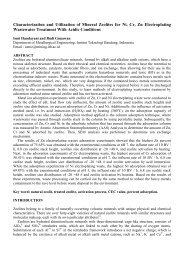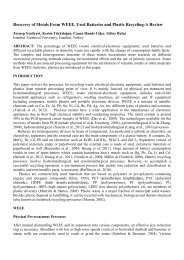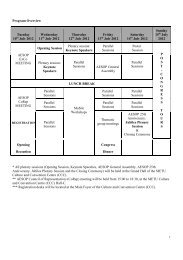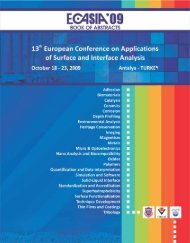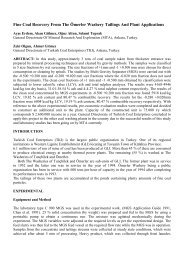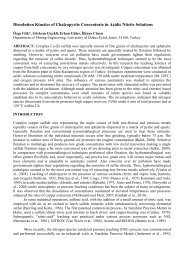The Effects of Drum Speed, Shake Frequency and Shake Amplitude ...
The Effects of Drum Speed, Shake Frequency and Shake Amplitude ...
The Effects of Drum Speed, Shake Frequency and Shake Amplitude ...
Create successful ePaper yourself
Turn your PDF publications into a flip-book with our unique Google optimized e-Paper software.
<strong>The</strong> <strong>Effects</strong> <strong>of</strong> <strong>Drum</strong> <strong>Speed</strong>, <strong>Shake</strong> <strong>Frequency</strong> <strong>and</strong> <strong>Shake</strong> <strong>Amplitude</strong> Combinations<br />
on Cleaning <strong>of</strong> Lignite Fines by Multi Gravity Separator<br />
Derya Oz Aksoy, Sabiha Koca<br />
Eskisehir Osmangazi University, Eskisehir, Turkey.<br />
Huseyin Koca<br />
Anadolu University, Eskisehir, Turkey.<br />
ABSTRACT: Significant amounts <strong>of</strong> fine coal are lost every year all over the world, because modern<br />
processing techniques are unable to recover very fine materials. Moreover many coals also contain high<br />
levels <strong>of</strong> sulphur <strong>and</strong> ash, which results in particulate matter <strong>and</strong> sulphur dioxide emissions when these<br />
materials are burned in coal fired power stations. <strong>The</strong>se emissions cause severe environmental pollutions<br />
<strong>and</strong> have to be reduced to an acceptable level. Physical processing methods are utilized widely to clean<br />
lignite fines. Gravity concentration techniques are preferred because <strong>of</strong> cheapness <strong>and</strong> easiness. Multi<br />
gravity separator is one <strong>of</strong> the recently designed gravity concentration device <strong>and</strong> preferred in fine coal<br />
cleaning due to its high performance. <strong>The</strong> variables <strong>of</strong> multi gravity separator such as drum speed, shake<br />
frequency <strong>and</strong> shake amplitude affect the separation performance significantly. In this work, the<br />
combinations <strong>of</strong> these parameters were studied to determine the optimum conditions <strong>of</strong> separation.<br />
INTRODUCTION<br />
In order to improve the recovery <strong>of</strong> fine coal, <strong>and</strong> at the same time to reduce the sulphur <strong>and</strong> ash content to<br />
an acceptable level, a number <strong>of</strong> fine coal cleaning techniques are available. Cleaning <strong>of</strong> coal by physical or<br />
chemical methods prior to combustion; Removing SO2 gasses by post-combustion control methods;<br />
Synthetic fuel production; <strong>and</strong> removing SO2 during combustion techniques can be utilized for this purpose<br />
(Rowson, 1986).<br />
Amongst these methods cleaning <strong>of</strong> coal prior to combustion involves either physical or chemical<br />
techniques or a combination <strong>of</strong> these. Physical processing methods such as gravity concentration are used in<br />
coal preparation plants widely despite their low efficiency particularly on desulphurization (Khory, 1981;<br />
Shah et al., 2002). Gravity concentration methods are the cheapest therefore they are preferred for economic<br />
reasons. <strong>The</strong> major limiting factor in gravity concentration is the dependence on particle size <strong>of</strong> coal. Pyritic<br />
sulphur is generally disseminated finely <strong>and</strong> can be liberated only by fine grinding. <strong>The</strong>refore fine coal<br />
cleaning should be applied.<br />
Multi Gravity Separator (MGS) was originally designed <strong>and</strong> used in fine metallic minerals<br />
concentration during 1990’s (Chan et al., 1991; Ozdag, et al., 1993, Udaya Bhaskar, et al., 2002). <strong>The</strong>n<br />
MGS was applied to fine coal cleaning (Erdem et al., 2008, 2010; Koca et al., 2000; Oz et al., 2009).<br />
MGS can increase gravity force up to 25 g that improves its ability to process finer materials<br />
<strong>Drum</strong> speed, shake frequency, shake amplitude, washwater flowrate <strong>and</strong> tilt angle are the most<br />
important variables that affect the separation <strong>of</strong> minerals in a MGS. As the particle size <strong>of</strong> the minerals<br />
gets finer, the interaction between these parameters gets more complicated <strong>and</strong> reduces the efficiency <strong>of</strong><br />
the cleaning process. <strong>The</strong>refore studies were conducted to determine the interactions <strong>of</strong> these variables.<br />
In another work done by the same authors, washwater flowrate <strong>and</strong> drum speed combinations <strong>of</strong> the<br />
MGS was studied in details to improve the performance <strong>of</strong> the process (Aksoy, et al., 2011). In this work,<br />
other important parameters <strong>of</strong> the MGS, namely shake frequency <strong>and</strong> shake amplitude were studied to<br />
determine the interaction with drum speed.
MATERIAL AND METHOD<br />
Lignite samples were taken from a nearby open pit coal mine. Samples were dry ground in open air <strong>and</strong><br />
ground to -0.212 mm in size. <strong>The</strong> ash content <strong>of</strong> the lignite sample is 42.56 %.<br />
<strong>The</strong> Mozley laboratory C 900 MGS were used in the experimental work. Its structure <strong>and</strong> operating<br />
conditions were given elsewhere (MGS Application Guide 1991; Chan et al. 1991).<strong>The</strong> feed to the MGS<br />
was prepared by mixing 500 grams <strong>of</strong> dry sample with one liter <strong>of</strong> water that gives 33 % solids<br />
concentration (by weight). <strong>The</strong> mixture was stirred continuously to maintain uniform suspension. <strong>The</strong><br />
MGS variables were adjusted at the required level as per the experimental design. <strong>The</strong> feed slurry was<br />
then fed to the MGS feed vessel at the required flow rate as the MGS was in operation. <strong>The</strong> separator was<br />
kept running until the material flow was finished, which took about 5 minutes, <strong>and</strong> MGS was stopped.<br />
Upper cover <strong>of</strong> the separator was removed, <strong>and</strong> remaining material in the drum was taken into equivalent<br />
fractions. Heavy product, which was collected through front launder, referred to as tailings, <strong>and</strong> light<br />
product, which was collected through back launder, referred to as concentrate.<br />
RESULTS AND DISCUSSION<br />
<strong>The</strong> effects <strong>of</strong> drum speed, shake frequency <strong>and</strong> shake amplitude combinations on the cleaning <strong>of</strong> lignite<br />
fines were studied. <strong>The</strong> other experimental conditions were kept constant as following:<br />
<strong>Drum</strong> speed : 220-260 rpm<br />
<strong>Shake</strong> frequency : 4-5 cps<br />
<strong>Shake</strong> amplitude : 10-20 mm<br />
Washwater flowrate : 1 l/min<br />
Feed density : 33 %<br />
Feeding duration : 90 sec<br />
Washing duration : 5 min<br />
Tilt angle : 0 o<br />
Results are given in graphs in terms <strong>of</strong> ash content <strong>and</strong> combustible recovery in the concentrate<br />
fraction. <strong>The</strong>re are a number variables which affect the separation <strong>of</strong> minerals in a multi gravity separator.<br />
It is thought that drum speed, shake frequency <strong>and</strong> shake amplitude are the most important ones. <strong>The</strong>re<br />
should be an optimum combination <strong>of</strong> these variables for a given minerals mixture.<br />
<strong>The</strong> effects <strong>of</strong> drum speed <strong>and</strong> shake frequency at 10, 15 <strong>and</strong> 20 mm shake amplitude are given in<br />
Figure 1-3.<br />
Ash, %<br />
44<br />
42<br />
40<br />
38<br />
36<br />
34<br />
32<br />
4 cps<br />
4.5 cps<br />
5 cps<br />
210 220 230 240 250 260 270<br />
<strong>Drum</strong> <strong>Speed</strong>, rpm<br />
75<br />
70<br />
65<br />
4 cps<br />
4.5 cps<br />
5 cps<br />
210 220 230 240 250 260 270<br />
<strong>Drum</strong> <strong>Speed</strong>, rpm<br />
(a) (b)<br />
Figure 1. <strong>The</strong> effects <strong>of</strong> drum speed <strong>and</strong> shake frequency on ash content (a) <strong>and</strong> combustible recovery (b)<br />
at 10 mm shake amplitude.<br />
Combustible Recovery, %<br />
100<br />
95<br />
90<br />
85<br />
80
(a) (b)<br />
Figure 2. <strong>The</strong> effects <strong>of</strong> drum speed <strong>and</strong> shake frequency on ash content (a) <strong>and</strong> combustible recovery (b)<br />
at 15 mm shake amplitude.<br />
Ash, %<br />
44<br />
42<br />
40<br />
38<br />
36<br />
Ash, %<br />
44<br />
42<br />
40<br />
38<br />
36<br />
34<br />
210 220 230 240 250 260 270<br />
<strong>Drum</strong> <strong>Speed</strong>, rpm<br />
4 cps<br />
4.5 cps<br />
5 cps<br />
4 cps<br />
4.5 cps<br />
5 cps<br />
34<br />
210 220 230 240 250 260 270<br />
<strong>Drum</strong> <strong>Speed</strong>, rpm<br />
Combustible Recovery, %<br />
85<br />
4 cps<br />
4.5 cps<br />
5 cps<br />
80<br />
210 220 230 240 250 260 270<br />
<strong>Drum</strong> <strong>Speed</strong>, rpm<br />
(a) (b)<br />
Figure 3. <strong>The</strong> effects <strong>of</strong> drum speed <strong>and</strong> shake frequency on ash content (a) <strong>and</strong> combustible recovery (b)<br />
at 20 mm shake amplitude.<br />
<strong>Drum</strong> speed <strong>of</strong> the MGS is one <strong>of</strong> the most important parameter that affects the separation<br />
significantly. <strong>Drum</strong> speeds between 160 <strong>and</strong> 300 rpm increase the g force from 7 to 25 g at the internal<br />
drum surface. <strong>The</strong> increased g force allows the separation <strong>of</strong> minerals that have smaller density<br />
differences <strong>and</strong> finer particle sizes (MGS Application Guide, 1991; Chan et al., 1991).<br />
<strong>The</strong> shake amplitude <strong>and</strong> shake frequency are important both in mechanism <strong>of</strong> bed dilation <strong>and</strong><br />
stratification, <strong>and</strong> for particle transportation. (Burt, 1984). <strong>The</strong> separation <strong>of</strong> particles in the drum takes<br />
place under the effects <strong>of</strong> shearing forces. Changes in amplitude <strong>and</strong> shake frequency <strong>of</strong> the MGS affect<br />
these forces as well as separation significantly. It was claimed in literature that there should be an<br />
optimum combination <strong>of</strong> shake amplitude <strong>and</strong> shake frequency for a given mineral mixtures (Ozdag et al.,<br />
1993).<br />
As can be seen from Figures 1-3, ash content <strong>of</strong> the concentrates decreased significantly with an<br />
increase in the drum speed at all studied combinations. <strong>The</strong> decrease in ash content in the concentrate was<br />
attributed to the increased g force at the internal drum surface. It should be noticed that separation was<br />
very poor at low drum speeds <strong>and</strong> most <strong>of</strong> the material was reported to the lights fraction. As the drum<br />
speed increases, the quality <strong>of</strong> the separation improves that causes ash reduction in the concentrate. This<br />
also causes the decrease in combustible recovery in the concentrate. <strong>The</strong>refore 260 rpm drum speed was<br />
chosen as optimum value.<br />
Longer amplitude causes more material to report the lights fraction. <strong>The</strong>refore, an increase in shake<br />
amplitude increases both ash content <strong>and</strong> combustible recovery significantly. <strong>Shake</strong> frequency affected the<br />
Combustible Recovery, %<br />
100<br />
95<br />
90<br />
100<br />
95<br />
90<br />
85<br />
80<br />
4 cps<br />
4.5 cps<br />
5 cps<br />
75<br />
210 220 230 240 250 260 270<br />
<strong>Drum</strong> <strong>Speed</strong>, rpm
esults in a different manner. At the shortest amplitude, lower frequency produced the best results while<br />
higher frequency produced better results at higher amplitudes.<br />
CONCLUSIONS<br />
<strong>Drum</strong> speed, shake frequency <strong>and</strong> shake amplitude are the most important variables that affect the<br />
separation <strong>of</strong> minerals in a MGS. As the particle size <strong>of</strong> the minerals gets finer, the interaction between<br />
these parameters gets more complicated <strong>and</strong> reduces the efficiency <strong>of</strong> the cleaning process. <strong>The</strong>refore<br />
studies were conducted to determine the interactions <strong>of</strong> these variables. After MGS experiments, the<br />
optimum conditions were determined as drum speed <strong>of</strong> 260 rpm, 10 mm shake amplitude <strong>and</strong> 4 cps shake<br />
frequency.<br />
At optimum conditions, ash content <strong>and</strong> combustible recovery <strong>of</strong> the concentrate were obtained as<br />
32,92% <strong>and</strong> 77,93%, respectively.<br />
<strong>The</strong> results <strong>and</strong> discussions indicate that drum speed affects the separation quality significantly. Higher<br />
drum speed gives the better results at all studied combinations. <strong>The</strong>re is a strong relationship between<br />
shake amplitude <strong>and</strong> shake frequency. Better results were obtained at slow frequency when amplitude was<br />
short. While the amplitude was longer, higher frequency produced better results.<br />
REFERENCES<br />
Aksoy, O. D., Koca, SD. And Koca, H., 2011. <strong>The</strong> <strong>Effects</strong> <strong>of</strong> Washwater Flowrate <strong>and</strong> <strong>Drum</strong> <strong>Speed</strong><br />
Combinations on Cleaning <strong>of</strong> Lignite Fines. Fifth International Conference on Clean Coal<br />
Technologies CCT2011, May, 8-12, 2011, Zarogoza, Spain.<br />
Burt, O. R., 1984. Gravity Concentration Technolgy, Amsterdam, <strong>The</strong> Nedherl<strong>and</strong>s, Elsevier Science<br />
Publishers B. V., p. 605.<br />
Chan, B. S. K., Mozley, R. H. <strong>and</strong> Childs, G. J. C., 1991. Extended Trials with the High Tonnage Multi<br />
Gravity Separator. Minerals Engineering, 4, p. 489-496.<br />
Erdem, A., Olgun, Z., Gulmez, A., Altun, O., Gitmez, A., Oteyaka, B. <strong>and</strong> Koca, S. 2008. Beneficiation<br />
<strong>of</strong> Lignites by Means <strong>of</strong> Shaking Table, MGS <strong>and</strong> Flotation, Project report 2, Project No. 106G056,<br />
MTA, Ankara.<br />
Erdem, A., Olgun, Z., Gulmez, A., Altun, O., Gitmez, A., Oteyaka, B. <strong>and</strong> Koca, S. 2010. Benefications<br />
<strong>of</strong> Coal Fines from Tailing Ponds <strong>of</strong> Tuncbilek Washing Plant. In Proceedings <strong>of</strong> the XXV.<br />
International Mineral Processing Congress, September, 6-10, Brisbane, Australia, 2010, p. 3737-3742.<br />
Khory, D.L., 1981. Coal Cleaning Technology, Khory, D.L. (ed.), New Jersey: Noyes Data Corp., p.367.<br />
Koca, H., Koca, S. <strong>and</strong> Karaoglu, M., 2000. Recovering <strong>of</strong> Fine Coal Particles from Tailing Ponds <strong>of</strong><br />
Ankara- Alpagut- Dodurga Coal Washing Plant. In Proceedings <strong>of</strong> the XI. International Conference on<br />
Environmental Issues <strong>and</strong> Management <strong>of</strong> Waste in Energy <strong>and</strong> Mineral Production SWEMP 2000,<br />
May 30-June 2, 2000, Calgary, Alberta, Canada, p. 117-121.<br />
MGS Application Guide, 1991. How to Get the Best from Your C-900 MGS. No.1, Richard Mozley Ltd,<br />
Cornwall, UK.<br />
Oz, D., Koca, S. <strong>and</strong> Koca, H., 2009. <strong>The</strong> Utilization <strong>of</strong> Unsaleable Lignite Fines at Eskişehir Koyunağılı<br />
Region Lignite Deposits. Physical Separation 09, June, 16-17, 2009, Falmouth, Engl<strong>and</strong>.<br />
Ozdag, H., Ucbas, Y. <strong>and</strong> Koca, S., 1993. Enrichment <strong>of</strong> Chromite Ore by Means <strong>of</strong> multi-Gravity<br />
Separator, Geosound, 23, p.167-176.<br />
Rowsan, N. A., 1986. Desulphurisation <strong>of</strong> Coal by Microwave Energy, Ph.D. thesis, Leeds University,<br />
UK.<br />
Shah, C.L., Abbott, J. A., Miles, M. J., Xuejun, L. <strong>and</strong> Jianping, X., 2002. Sulphur Reduction Evaluation<br />
<strong>of</strong> Selected High-Sulphur Chinese Coals. Fuel, 81, p. 519-529.
Udaya Bhaskar, K., Govindarajan, B., Barnwal, J. P., Venuggopal, R., Jakhu, M. R. <strong>and</strong> Rao, T. C., 2002.<br />
Performance <strong>and</strong> Modelling Studies <strong>of</strong> an MGS for Graphite Rejection in a Lead Concentrate.<br />
International Journal <strong>of</strong> Mineral Processing, 67, p. 59-70.


